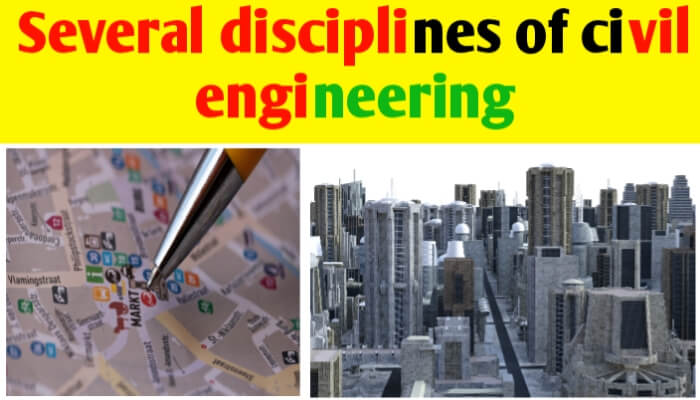Civil engineering encompasses various branches, including:
1. Structural Engineering: Focuses on designing and analyzing structures like buildings and bridges.
2. Geotechnical Engineering: Involves the study of soil and rock mechanics to design foundations and slopes.
3. Transportation Engineering: Deals with the planning and design of transportation systems, such as roads, highways, and railways.
4. Environmental Engineering: Concerned with protecting and improving the environment, including water and air quality.
5. Water Resources Engineering: Involves the management of water resources, such as water supply, drainage, and flood control.
6. Construction Engineering: Manages construction projects, ensuring they are completed efficiently and within budget.
7. Coastal Engineering: Focuses on the design and construction of structures along coastlines to combat erosion and flooding.
8. Materials Engineering: Studies the properties and applications of construction materials like concrete and steel.
9. Urban and Regional Planning: Involves planning and designing communities to ensure sustainable development.
Hi guys images only we know about several branches of civil engineering and their disciplines like material engineering ,structural engineering, construction technology environmental engineering and transport engineering.
What are different branches of civil engineering? Branches of civil engineering are following:-
● Architecture and town planning
● Building material & construction technology
● Environmental engineering
● Geotechnical engineering
● Hydraulics, water resources and irrigation engineering
● Remote sensing and GIS
● Structural engineering
● Surveying
● Transportation engineering
● Remote sensing and GIS.

Civil engineering is regarded as one of the most important engineering fields across the globe. The industry is about solving real world problems through designing, constructing, managing and maintaining the infrastructure that plays a vital role in the development of countries and supports modern society. This includes buildings, bridges, roads, airports, dams, sewage systems, flood mitigation works and so on; the list is endless. Civil engineers are at the forefront of innovation in our societies.
As you can see, although civil engineering is a profession that generally focuses on creating physical manmade structures, it is an extremely broad field that encompasses multiple sub-disciplines. In this guide, we’ve explained some of the key areas of this sector.
What are disciplines of civil engineering? there are several disciplines of civil engineering architect and town planning, building material, construction technology, environmental engineering, geotechnical engineering, hydraulics water resources and irrigation engineering, remote sensing and GIS, structural engineering, surveying and transportation engineering.
What are different branches of civil engineering?
Branches of civil engineering:-There are several branches of civil engineering are following:- Architect and town planning, Building material & construction technology, Environmental engineering, Geotechnical engineering, Hydraulics water resources and irrigation engineering, Remote sensing and GIS, Structural engineering, Surveying and Transportation engineering.
Architecture and town planning:- giving beauty to building is architecture, it enhancing the appearance of building and maintaining the Heritage. Proper planning of towns and cities consist of planning the layout, planning the road, separating the commercial, residential, academic and industries areas, planning greenbelt, planning sewage disposal unit and planning water treatment plants and water storage unit. Presently architecture and town planning engineering is separated from Civil Engineering.
Building material technology:- this deal with material used for construction. Bricks,block, concrete, tiles, soil, cement, stones and steel aggregates, glass, wood, plastic etc include construction materials, some are natural and many are human made.
Construction technology and management:- it deals with planning, scheduling and execution of construction activity related to project. It comprises of Manpower, material, time and money management. It emphasis will be on new construction practice, use of appropriate and local Technology, safety of men and material, utilisation of marginal material etc.
Work of construction manager:– Construction managers review contracts, order materials, higher and schedule subcontractors. the job of construction manager is to provide quality control and ensure project is completed on time and within budget.

Environmental engineering:– environment is the available nature around us, it include the life support system such as water,air and land soil. Environmental engineering deals with the technology to save nature from human and natural abuse and pollution, this study involves balanced compromise between environment and safety. Environmental engineering deals with the technique of water collection, purification and supply,waste water collection treatment and disposal, control of all type of pollution.
Geotechnical engineering:- all structures are founded on ground, forces from structure are safely transferred to soil. It is essential to understand ground behaviour and interaction between soil and structure is a study under geotechnical engineering. It involves Foundation, slope, retaining structure, Highway pavement design, embankment and earth Dam, tunnels, underground structure and deep cut.
Geotechnical engineering is used to assess the quality of soil or Rock to carry the structure, proper knowledge of geotechnical engineering is necessary for safety and stability of a structure.
Hydraulics, water resources and irrigation engineering:- hydraulic deal with mechanics of water flow. Water resource engineering deals with identification and utilisation of available water resource & minimising the loss. surface water river and lake water and groundwater are fully managed, this also deals with ground water utilisation, groundwater recharge and rain water harvesting.
Irrigation engineering deals with water management for agriculture purpose. Dams are constructed at the desired location to store water in reservoir when the supply from river is good and to utilise for useful purpose during drought. Canals are built for this purpose. during excess input, water is allowed to main river through the body of them to avoid flooding.
Remote sensing and GIS:- this is one of new field, this improvement in space Technology, availability of GPS inhence the scope of Geography information about system. Good mapping technique helps to get required information accurately and quickly to effectively manage and monitor the available resources for optimal use. GIS is in Hi-Tech equivalent of map, it represent a means to locate ourselves in relation to world around us, it deals with measurement mapping monitoring and modelling of geographic information around us.
Structural engineering:– structure in the assemblance of two or more basic elements such as beam, slab, column, truss, frame, shells, etc. It involves determination of support reactions, member forces and moments deflection and deformation.
planning of position layout of different elements and design determination of size shape and material of component such that the safety and serviceability requirements are not sacrificed at economy is considered. Repair rehabilitation and maintenance is part of a structural engineering. Dams Bridge Stadium auditoriums multi storey building analysis and design.
Serveying:- Sarveying is activity involved in location of topographic feature of location for a future construction. feasibility survey, alternate and most suitable methods involve, it helps in environment impact assessment. Objectives of serving is execution of Survey to collect topographic data, Calculation and Analysis of data, plotting survey data to create design maps, provision of line, grade and other layout works.
Transport engineering:- application of scientific approach (planning, design, operation and management) of Transportation system such as Road, Railways, sea river and air transport. It involves planning design construction operation and maintenance of transportation facility.